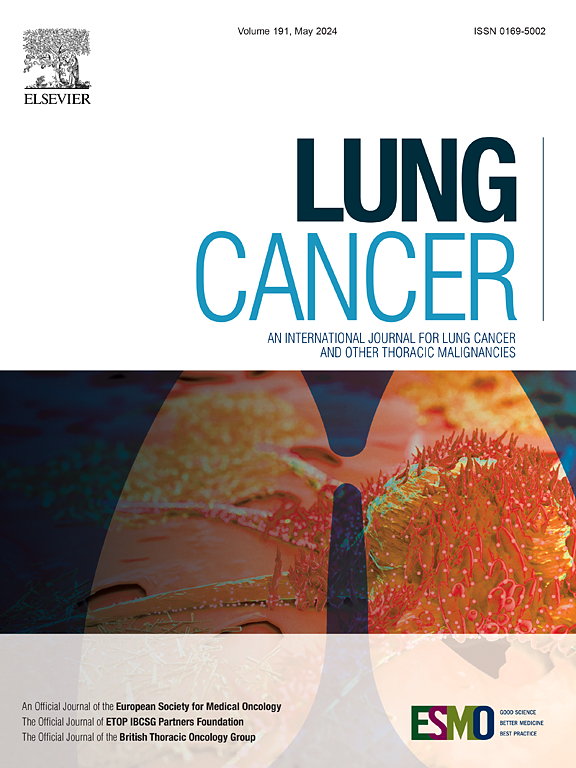Value of 18F-FDG PET metabolic parameters combined with the dynamic monitoring of molecular residual disease (MRD) in predicting the prognosis of non-small-cell lung cancer after surgery
IF 4.4
2区 医学
Q1 ONCOLOGY
引用次数: 0
Abstract
Objective
To study the ability of the combination of 18F-FDG positron-emission tomography/computed tomography (PET/CT) metabolic parameters and the dynamic monitoring of molecular residual disease (MRD) in predicting the prognosis of non-small-cell lung cancer (NSCLC) after surgery.
Methods
The clinical data and disease-free survival (DFS) data of 157 NSCLC patients who underwent 18F-FDG PET/CT at 2 weeks before surgery and were regularly monitored for MRD after surgery were retrospectively analyzed. The correlation between PET metabolic parameters and the dynamic monitoring of MRD and the values of the two in predicting prognosis of NSCLC were analyzed.
Results
Survival analysis revealed that patients with elevated 18F-FDG PET metabolism had a worse prognosis, while MRD-positive patients had a significantly worse prognosis than MRD-negative patients. By combining of PET metabolic parameters and MRD status, the PET-high-metabolism + MRD-positive group had a worse prognosis than the PET-high-metabolism + MRD-negative group or the PET-low-metabolism + MRD-positive group and the PET-low-metabolism + MRD-negative group. The prognostic model established by tumor TNM staging, clinical data and PET metabolic parameters(comd 1 model) had a high predictive value (C-index: 0.759, 95 % CI: 0.683–0.835). After adding this model to the MRD detection results(comd 2 model), the prognostic accuracy of the model improved (C-index: 0.873, 95 % CI: 0.824–0.922).
Conclusion
The prognostic model made up of Tumor TNM staging,18F-FDG PET metabolic parameters and clinical data can accurately predict recurrence in NSCLC patients after surgery. Incorporating the results of the dynamic monitoring of MRD detection into the model can significantly enhance its the prognostic accuracy.
18F-FDG PET代谢参数联合分子残留病(MRD)动态监测对非小细胞肺癌术后预后的预测价值
目的探讨18F-FDG正电子发射断层扫描/计算机断层扫描(PET/CT)代谢参数联合分子残留病动态监测(MRD)对非小细胞肺癌(NSCLC)术后预后的预测能力。方法回顾性分析157例非小细胞肺癌患者术前2周行18F-FDG PET/CT检查,术后定期监测MRD的临床资料和无病生存期(DFS)。分析PET代谢参数与MRD动态监测的相关性及其对NSCLC预后的预测价值。结果生存分析显示,18F-FDG PET代谢升高的患者预后较差,mrd阳性患者的预后明显差于mrd阴性患者。结合PET代谢参数和MRD状态,PET高代谢+ MRD阳性组的预后差于PET高代谢+ MRD阴性组或PET低代谢+ MRD阳性组和PET低代谢+ MRD阴性组。结合肿瘤TNM分期、临床资料及PET代谢参数建立的预后模型(comd 1模型)具有较高的预测价值(C-index: 0.759, 95% CI: 0.683-0.835)。将该模型加入MRD检测结果(comd 2模型)后,模型的预后准确率提高(C-index: 0.873, 95% CI: 0.824-0.922)。结论由肿瘤TNM分期、18F-FDG - PET代谢参数及临床资料组成的预后模型可准确预测非小细胞肺癌患者术后复发。将MRD检测的动态监测结果纳入模型,可以显著提高模型的预测精度。
本文章由计算机程序翻译,如有差异,请以英文原文为准。
求助全文
约1分钟内获得全文
求助全文
来源期刊

Lung Cancer
医学-呼吸系统
CiteScore
9.40
自引率
3.80%
发文量
407
审稿时长
25 days
期刊介绍:
Lung Cancer is an international publication covering the clinical, translational and basic science of malignancies of the lung and chest region.Original research articles, early reports, review articles, editorials and correspondence covering the prevention, epidemiology and etiology, basic biology, pathology, clinical assessment, surgery, chemotherapy, radiotherapy, combined treatment modalities, other treatment modalities and outcomes of lung cancer are welcome.
 求助内容:
求助内容: 应助结果提醒方式:
应助结果提醒方式:


